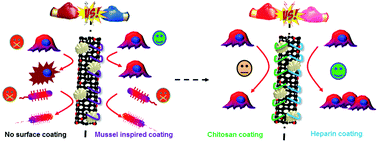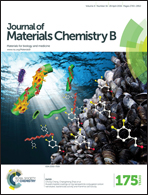Mussel-inspired coatings on Ag nanoparticle-conjugated carbon nanotubes: bactericidal activity and mammal cell toxicity†
Abstract
Silver nanoparticle (AgNP)-based nanohybrids have been proposed as efficient antimicrobial agents because of their robust bactericidal activity. However, the direct exposure of AgNPs poses a threat towards mammalian cells. In this article, we report a facile mussel-inspired approach to introduce functional biopolymer coatings to shield AgNP-loaded oxidized carbon nanotubes (AgNPs@oCNT), as well as to modify the interface properties. Two kinds of dopamine-grafted functional biopolymers, heparin and chitosan, were used to reduce the Ag+ ions pre-absorbed onto the oCNT surface and simultaneously form protective coating layers. Their effects on the bactericidal activity and mammal cell biocompatibility of the AgNPs@oCNT were compared. The TEM, FTIR, and XPS results clearly verified the loading of AgNPs and the coating of functional biopolymer on the oCNT surface. Studies of broth turbidity, bacterial growth kinetics, agar plate counts, and live/dead bacterial staining revealed that the biopolymer-coated nanohybrids exhibited robust bactericidal activity against both Gram negative and Gram positive bacteria, and were as effective as bare AgNPs@oCNT hybrids. The chitosan-coated samples were particularly effective because of the synergistic effects of chitosan and AgNPs. The shielding effects of the anchored functional biopolymers gave the AgNP-based nanohybrids good compatibility with endothelial cells, especially for the heparin-coated samples.


 Please wait while we load your content...
Please wait while we load your content...